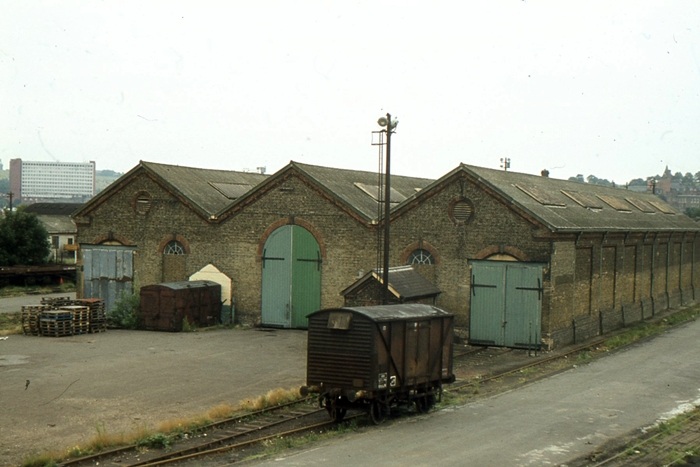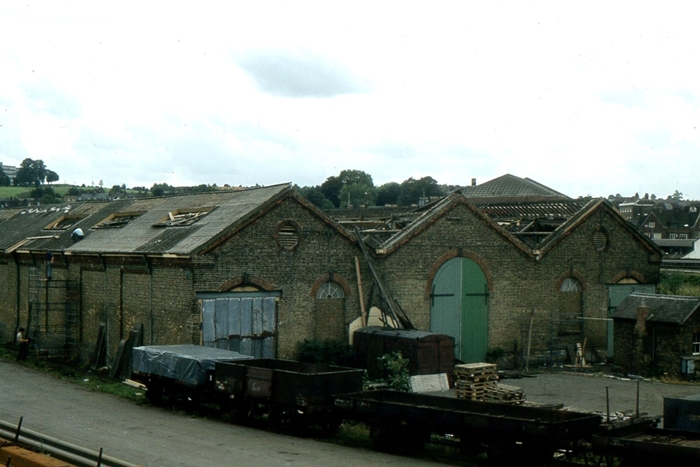
Rochester Freight Depot & Chatham Sidings
General decline of freight traffic by rail under British Railways auspices led to inevitable goods yard closures at stations. Indeed, the Kent Coast Electrification had its part to play, where platform extensions and layout revisions required the abolition of freight sidings and loops – Chatham’s 1959 revisions exist as good examples of the latter case. Being on a large area of land detached from the station, the goods yard at Rochester avoided any economising measures required by those facilities immediately adjacent to the platforms. In the trade, the yard here was known as Rochester Freight Depot and Chatham Sidings: essentially, Rochester Freight Depot occupied the land to the south of Blue Boar Lane Level Crossing, whilst the area of sidings to the north formed Chatham Sidings. Matters, however, were somewhat confused given that parts of the freight depot did extend north of the level crossing (e.g. the vehicle loading dock).
Yards at both Rochester and Strood Docks survived beyond the 1960s. Thereafter, that at Rochester continued to handle sand and mineral traffic; like at nearby Hoo Junction, the yard was used for both re-marshalling freight formations and for the storage of wagons. The 1972 opening of Sheerness Steel Works also brought additional steel traffic to the goods depot. By 1980, the yard at Rochester was being shunted by those ''main line'' locomotives native to the South Eastern Division - Classes 33 and 73 - but in addition to these, Hither Green provided a diesel shunter to work the yard. At the weekends, the shunter could be found the 2½ miles down the line at Gillingham, where locomotive stabling sidings were provided, and every so often the locomotive would return to Hither Green. British Rail's own shunter was joined at Rochester by another diminutive diesel locomotive, this being privately-owned and having an 0-4-0 wheel arrangement. The latter was named ''Thalia'' (Works No. 7816), and the locomotive was on site to shunt mineral freights between the yard and an adjacent aggregate works. After withdrawal, the shunter entered preservation at the restored heritage area of Chatham Dockyard.
Strood lost its general goods traffic during August 1971, but sidings here remained in use beyond this date for the handling of coal and china clay. Significant freight yards also continued to exist at Rochester, Hoo Junction, and Tonbridge. The latter two were vast compared with the site at Rochester, having – under Southern Railway guidance – developed into multitudes of sidings in-between diverging routes. Furthermore, the ex-LC&DR site was allowed to decline over ensuing years, resulting in the impressive goods shed losing its roof, in addition to the seemingly customary deterioration of sidings and the spread of vegetation over the lines. Nevertheless, this did not stop the yard remaining on British Rail’s books as a freight depot until the Summer of 1988, after which the sidings played host to condemned wagons. By 1995, the sidings were no longer used, and over the next ten years a programme of track lifting ensued, the lattice footbridge finally succumbing in 2005.
Early 1970s
The goods shed can just be seen at the top edge of this photograph, which shows scrap metal being loaded into 16-ton wagons. This scrap metal contract was in operation due to the fall off of conventional traffic. © Roger Goodrum
Early 1970s
Looking back towards the Medway, we can see that the coal operation had disappeared since the earlier view, although there was a good amount of general traffic. The 16-ton wagons in the background were used for gypsum from Mountfield to a company on the riverside. © Roger Goodrum
1980

This view from about 1980 shows the huge ex-LC&DR goods shed, shortly before work commenced to remove the roof. Under the layer of grime is the LC&DR's familiar crème brickwork with orange lining. Note the grounded wagon body which, looking at the outline on the goods shed's wall, replaced a hut. © Roger Goodrum
1980

A second view from the lattice footbridge shows roof demolition in progress. As subsequent photographs show, the pitched roof sections of the brickwork were levelled to the height of the side walls. © Roger Goodrum
Return to the Kent Rail Homepage or alternatively, check for Updates.
Website & Copyright information - Links - Contact the Webmaster
All content is copyright © David Glasspool unless otherwise stated